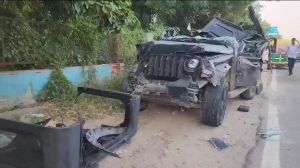A moment for a statesman
Such hai dard-e-mushtaraq/ mein hai woh rooh-e-ittehad!True, a common tragedy has the power to bind us inseparably.— Josh There were te...

Such hai dard-e-mushtaraq/ mein hai woh rooh-e-ittehad!
True, a common tragedy has the power to bind us inseparably.
— Josh
There were teasing kneejerk offers of Indian help as soon as the unspeakable human tragedy unfolded in Muzaffarabad and its environs. The worst earthquake in history has hit the Pakistan side of Kashmir but families on both sides of the LoC have been destroyed. What should we do?
The expectation that offers of help would be spontaneously lapped up were unrealistic. From General Pervez Musharraf downwards, an elaborate chain of command involving the army, internal security, civil administration, the ISI, all have a say on what level of help to seek from anywhere, including Indians. A spontaneous offer, not carefully thought through, would invite a spontaneously awkward response. This is exactly what happened.
But help is required, on both sides, and logistically there is no easier access to the wailing millions on both sides than from the two parts of Kashmir. Mirwaiz Mohammad Farooq may have a point. Where are the NGOs, concerned members of civil society, reaching out with help and, more important, with the healing touch? Comparisons will be made with the private, non governmental help that reached Latur and Bhuj in a jiffy. In the pressure of the moment, such questions can begin to nag the mind.
Actually, there is such a burst of sympathy that there is not sufficient organisation on the ground, in Srinagar or Muzaffarabad, to process all the help coming in. Two days ago an IL-76 loaded with 20 tonnes of material could not take off from Palam airport because the airport at Islamabad was choked. Jamiat-e-ulema e Hind has a plane load of material ready for dispatch and is awaiting clearances. Other organisations are ready with equipment. This when Turkey, Britain, China and a host of countries are already on the spot with their post earthquake management teams. But just the day equipment was desperately needed for the young and the infirm, a premature cloud burst, followed by a hailstorm, impeded relief.
Prakash Karat and Sitaram Yechury have visited the Pakistan High Commission with cheques of a few crores by way of relief. Kashmir leader Yasin Malik has left for Muzaffarabad to organise future co-ordination.
To compound the chaos and the tragedy, Indians and Pakistanis who had travelled across by the Srinagar-Muzaffarabad bus have been stranded in each other’s countries — 54 Indians in Muzaffarabad and 41 Pakistanis in India. Those in Pakistan can contact their relatives in India but mobile phones do not work in the reverse direction.
Thus cut off, 6 Indians in Muzaffarabad carrying one dead body and 2 injured, have been able to contact the Indian side. They are cut off in every way except that miraculous instrument called the mobile. Their relatives have persuaded MEA to arrange for a private helicopter.
The initial freelance offers of help and the curt response have been amplified in such a way that the impression has gained ground that a sixty-year-old equation of hostility is not amenable to co-operation even in the midst of unprecedented natural calamity. This cannot reflect well on the dialogue process which has been carried miles since the January 6, 2004 Islamabad declaration.
Here is an opportunity Prime Minister Manmohan Singh must not miss. A unilateral announcement of a ceasefire before the Friday prayers will electrify the atmosphere. It will win hearts and minds like nothing else will — on both sides of the border. Prime Minister Singh and General Musharraf have been speaking over the telephone. An announcement may result.
Incidentally, what happened to the tsunami model?
Remember, the tsunami struck on Boxing Day, December 26, 2004. It was a holiday for naval officers and their families. But within minutes of the calamity registering with Naval Headquarters, 37 Indian naval ships were diverted to Sri Lanka, Maldives and Aceh in Indonesia.
Captain K. Muralidharan Nair rushed with his vessel towards Trincomallee’s INS Sarvekshak and Captain T.K. Asokan’s command, Captain Satyendra Vaidya, was advised to leave his station in Vizag. There was frenetic activity. In a matter of days, Indian naval officers opened up the Galle Port for navigation, something that Lakshman Kadirgamar, the late foreign minister of Sri Lanka, mentioned to me with total admiration.
The US ship Duluth arrives two weeks after the the event. But the MEA had announced the tsunami as a model of co-operation in regional situations between India, US and EU. Later this co-ordination was attempted in the new political situation the king had imposed on Nepal.
One is not hearing anything about the tsunami models in the context of the latest earthquake. I wonder why.





- 01
- 02
- 03
- 04
- 05


























